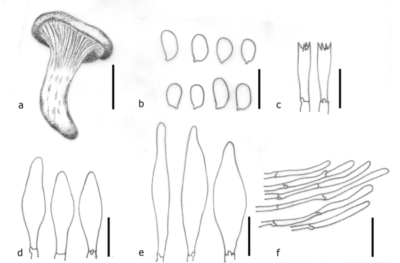Fungalpedia – Note 232, Paxillus
Paxillus Fr.
Citation if using this entry: Khyaju et al. 2024 (in prep.) – Fungalpedia, Basidiomycota 4
Index Fungorum, Facesoffungi, Mycobank, GenBank, Fig.1
Classification: Paxillaceae, Boletales, Agaricomycetidae, Agaricomycetes, Agaricomycotina, Basidiomycota, Fungi
Paxillus Fr. was established by Fries (1821). Paxillus species form ectomycorrhizal relationships with a range of host plants and are widely distributed in the northern hemisphere (Vellinga et al. 2012). Currently, Index Fungorum (2023) reports a total of 186 records of Paxillus. However, He et al. (2019) accepted only 19 species within this genus.
Vellinga et al. (2012) reported two main species clusters: Paxillus rubicundulus P.D. Orton related species associated with Alnus hosts, and P. involutus complexes with a range of host trees. Paxillus is characterized by having fleshy fruiting bodies, range from medium to large, and exhibit ochraceous-yellow to chestnut-brown or dark-brown colours (Gelardi et al. 2014). The pileus is funnel-shaped, involute margin in young sporophores. The lamellae are deeply decurrent, interveined towards the stipe, easily detachable, and reddening or browning tissues on bruising (Gelardi et al. 2014). The trichodermal pileipellis consists of filamentous hyphae, bi-lateral divergent hymenophoral trama, and an absent lateral stipe stratum (Šutara 1992, Watling 2008, Gelardi et al. 2014). Basidiospores are broadly ellipsoid, smooth, and cyanophilic (Šutara 1992, Watling 2008, Gelardi et al. 2014). The spore print is rusty brown to reddish-brown (Gelardi et al. 2014). Clamp connections are present.
Paxillus involutus has been the only species within Paxillus for several decades, serving as the type species (Jargeat et al. 2016). Paxillus was proved to be monophyletic with samples from Northern hemisphere only (Watling 2008, Vellinga et al. 2012, Gelardi et al. 2014). However, later species of Paxillus reported from Southern Hemisphere exhibited separate lineage (Bresinsky et al. 1999). The challenge of identifying species within Paxillus, related to the polymorphic basidiome, is resolved by using the genetic marker of the ITS gene (Hahn & Agerer 1999, Gelardi et al. 2014).
Regarding human consumption, the type species P. involutus is poisonous due to immune haemolysis (Winkelmann et al. 1986, Jaroshch & Bresinsky 1999, Anthowiak et al. 2003).
Synonymy: Parapaxillus Singer; Paxillopsis E.-J. Gilbert; Rhymovis Pers. ex Rabenh.; Ruthea Opat.,
Type species: Paxillus involutus (Batsch) Fr.
Basionym: Agaricus involutus Batsch
Other accepted species: (Species Fungorum – search Paxillus)
Figure 1 − Paxillus orientalis. a Basidiomata. b Basidiospores. c Basidia. d Cheilocystidia. e Pleurocystidia. f Pileipellis. Scale bar: a = 25 mm, b = 10 µm, c-e = 20 µm, f = 40 µm. Redrawn from Gelardi et al. (2014).
References
Fries EM, 1821 − Systema mycologicum, sistens fungorum ordines, genera et species,
hujusque cognitas, quas ad normam methodi naturalis determinavit, disposuit atque
Entry by
Sabin Khyaju, Center of Excellence in Fungal Research, Mae Fah Luang University, Chiang Rai, Thailand
(Edited by Samaneh Chaharmiri-Dokhaharani, Thatsanee Luangharn, Achala R. Rathnayaka)
Published online 19 April 2024
